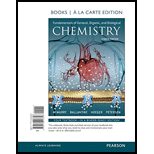
Concept explainers
Interpretation:
Example of a protein containing primarily beta-sheets and also identify the protein mentioned is globular or fibrous.
Concept introduction:
Many amino acids are linked together through amide bonds to form a biologically large molecule known to be proteins.
Amino functional group is
Secondary structure of protein is the repeating structural patterns (
Fibrous protein is a tough, water insoluble protein whose protein chains form fibers or sheets.
Globular protein is a water soluble protein whose chain is folded in a compact shape.
Want to see the full answer?
Check out a sample textbook solution
Chapter 18 Solutions
Fundamentals of General, Organic, and Biological Chemistry, Books a la Carte Edition (8th Edition)
- A particular amino acid contains a- CHNH3+ group. Is this amino acid more likely to be found on the inside or the outside of the folded protein? Briefly explain.arrow_forwardGlobular proteins are typically constructed from several layers of secondary structure, with a hydrophobic core and a hydrophilic surface. Is this true for a fibrous protein such as keratin?arrow_forwardGive an example of a protein that has quaternary structure. How many polypeptide chains are present in this protein?arrow_forward
- Which of the amino acids would be most likely to be located on the surface of a protein?arrow_forwardWhich of the following amino acids is most likely to be found on the outside of a soluble protein, and which of them is more likely to be found on the inside? Explain each answer. (Hint: Consider the effect of the amino acidside chain in each case and that the protein is folded up into its globular form.)(a) Valine (b) Aspartate(c) Histidine (d) Alaninearrow_forwardHemoglobin is a tetramer consisting of two a and two b chains. What level of protein structure is described in the above statement?arrow_forward
- Describe the following levels of protein organization and give an example of each: A.) Primary B.) Secondary C.) Tertiary D.) Quarternaryarrow_forwardWhat is the approximate molecular weight of a protein with 682 amino acid residues in a single polypeptide chain?arrow_forwardGlobular proteins are water-soluble, whereas fibrous proteins are insoluble in water. Indicate whether you expect the following amino acids to be on the surface of a globular protein or on the surface of a fibrous protein.(a) Ala (b) Glu(c) Leu (d) Phe(e) Ser (f) Valarrow_forward
- Are proteins with the same number of each different amino acid that form them necessarily identical proteins?arrow_forwardAn amino acids unique property arises through which component? How does this same component contribute to the overall chemical nature of the protein?arrow_forwardwhich categories of amino acid would you expect to find on a soluble proteins surface in which would you expect to find in the interior?arrow_forward
